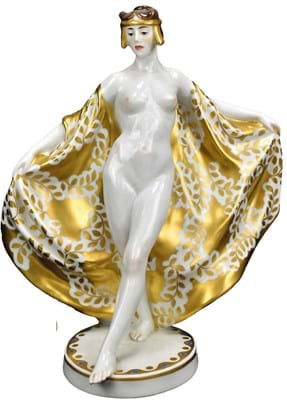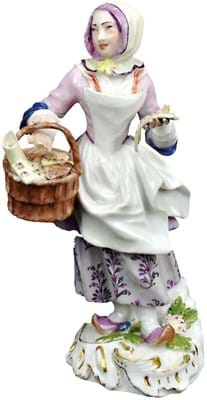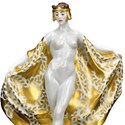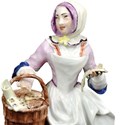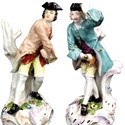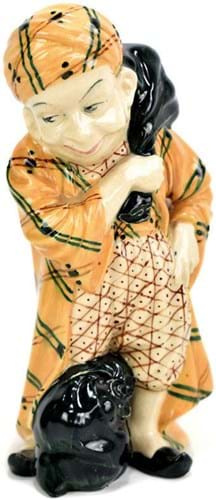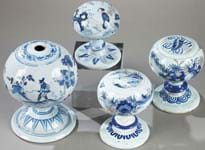International bidders competed online and by phone against the UK trade and at least one well-known local collector in the Macclesfield rooms on August 8.
The pieces were the first tranche of about 350 figurines amassed by a Worcestershire couple who built an extension on their home to house the display cabinets. Rather than flood a fragile market, auctioneer Chris Surfleet is offering them over a series of sales this autumn and next year.
Sensible estimates
Of the 27 pieces of Meissen offered in this first selection, half were mid-18th century. In varying condition but generally good with only minor restoration, all got away against sensible estimates garnering £15,260, a shade above top hopes.
It is symptomatic of the market that prices were probably considerably less than those paid to good dealers 20-30 years ago.
The best-seller was a 5½in (14cm) c.1757 figure of a pastry seller from the Cris de Paris series by Kaendler’s assistant Paul Reinicke. The figure, numbered 16 and with the blue crossed swords mark, was pitched at £1000-1500 but sold at £3500.
From the same series, Reinicke’s c.1755-57, 6in (15cm) tall figure The Nightwatchman went at a five-times-estimate £2650 and Town Crier (or Oboe Player) tripled hopes at £2100.
By contrast, figures by Kaendler himself often fell short of what appeared to be reasonable estimates, including a rare pair of his c.1755 The Duellists. The 8in (20cm) tall elegantly dressed gentlemen depicted drawing their swords were guided at £2000-3000 but sold to at £1450.
His c.1750 Lady Street Cook standing 6½in (16.5cm) tall did double the lower estimate at £1000 but from his earlier figures of musicians The Cellist of c.1742 took a mid-estimate £560 and Hurdy Gurdy Player went below hopes at £600.
These were the sort of prices which a couple of decades back could be expected for the mid-to-late 19th century revivalist figures which design director Ernst Leuteritz put into production at Dresden.
Examples at Macclesfield included a c.1870, 4in (10cm) tall figure of a girl picking grapes at a mid-estimate £120, a 6in (15cm) c.1880 a figure of the conductor from the Dresden Opera series going a shade below estimate at £190 and a 7½in (19cm) tall figure of a gentleman with a telescope which, despite considerable condition problems and the catalogue caveat a/f, took £170 against a £30-50 estimate.
Of the dozen post-18th century pieces in the collection, the best-seller was from Meissen’s tentative steps into the world of Art Deco.
This was an 11in (28cm) tall naked dancer designed by Theodore Eichler. The c.1935 figure with painted marks to the base and inscribed B256 was pitched at £1500-2000 and sold at £2200.
Peterloo remembered
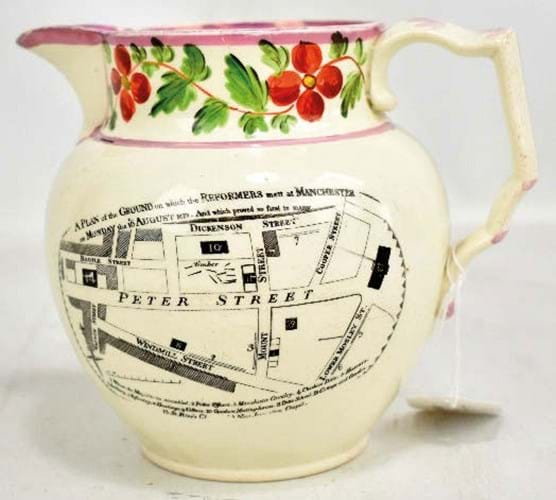
Peterloo Massacre jug c.1819 – £1450 at Adam Partridge in Macclesfield.
Two English pieces also caught the eye. Catalogued as ‘of local interest’ but surely of wider appeal was a rare commemorative pink lustre pearlware jug detailing the Peterloo Massacre, a contemporaneous production marking the protest in which the mounted militia killed at least 17 of the crowd who had come to hear Henry ‘Orator’ Hunt speak on electoral reform.
To one side the jug showed a map of the area around Peter Street, Manchester, and A plan of the Ground on which the Reformers met at Manchester on Monday the 16 August 1819, And which proved so fatal to so many.
Inscribed to the reverse No Corn Bill Universal Suffrage, Annual Parliaments and vote by ballot, the 5¾in (14.5cm) tall jug was in fine condition barring a glaze chip to the rim and some staining to the base. Against a £600-800 estimate, it sold at £1450.
Royal Doulton figure collectors know all too well of the plunge in prices over the past few years.
However, rarities such as the Harry Tittensor creation One of the Forty (HN666) are the exception. This 7¼in (18cm) figure, based on the Arabian Knights story line, produced in small numbers and in different colourways from 1921-38, was in fine condition.
Spotted by new recruit and junior cataloguer James Bird at his first house clearance, it sold at £2700 (estimate £300-500).


